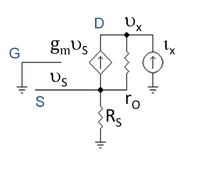Borel's lemma: Difference between revisions
en>Mathsci |
en>David Eppstein m →References: authorlink Marty Golubitsky |
||
| Line 1: | Line 1: | ||
{{More footnotes|date=April 2009}} | |||
[[File:Common Gate.svg|thumbnail|200px| Figure 1: Basic N-channel common-gate circuit (neglecting [[biasing]] details); current source ''I<sub>D</sub>'' represents an [[active load]]; signal is applied at node ''V<sub>in</sub>'' and output is taken from node ''V<sub>out</sub>''; output can be current or voltage]] | |||
In [[electronics]], a '''common-gate''' [[electronic amplifier|amplifier]] is one of three basic single-stage [[field-effect transistor]] (FET) amplifier topologies, typically used as a [[Electric current|current]] [[buffer amplifier|buffer]] or [[voltage]] [[amplifier]]. In this circuit the source terminal of the transistor serves as the input, the drain is the output and the gate is connected to ground, or "common," hence its name. | |||
The analogous [[bipolar junction transistor]] circuit is the [[common base|common-base amplifier]]. | |||
==Applications== | |||
This configuration is used less often than the [[common source]] or [[source follower]]. It is useful in, for example, CMOS RF receivers, especially when operating near the frequency limitations of the FETs; it is desirable because of the ease of [[impedance matching]] and potentially has lower [[Electronic noise|noise]]. Gray and Meyer<ref name=Gray-Meyer> | |||
{{cite book | |||
|author=Paul R. Gray, Paul J. Hurst, Stephen H. Lewis, Robert G. Meyer | |||
|title=Analysis and Design of Analog Integrated Circuits | |||
|year= 2001 | |||
|edition=4th | |||
|publisher=Wiley | |||
|location=New York | |||
|isbn=0-471-32168-0 | |||
|pages=186–191}} | |||
</ref> provide a general reference for this circuit. | |||
==Low-frequency characteristics== | |||
[[File:Common gate hybrid pi.PNG|thumbnail|200px| Figure 2: Small-signal low-frequency [[hybrid-pi model]] for amplifier driven by a [[Norton's theorem|Norton signal source]]]] | |||
At low frequencies and under [[small-signal]] conditions, the circuit in Figure 1 can be represented by that in Figure 2, where the [[hybrid-pi model]] for the MOSFET has been employed. | |||
[[File:Common gate output resistance.PNG|thumbnail|200px| Figure 3: Hybrid pi model with test source ''i<sub>x</sub>'' at output to find [[output resistance]]]] | |||
The amplifier characteristics are summarized below in Table 1. The approximate expressions use the assumptions (usually accurate) ''r<sub>O</sub>'' >> ''R<sub>L</sub>'' and ''g<sub>m</sub>r<sub>O</sub>'' >> 1. | |||
{| class="wikitable" style="background:white;text-align:center;margin: 1em auto 1em auto 1em auto 1em auto" | |||
!Table 1 !! Definition !! Expression !! Approximate expression | |||
|-valign="center" | |||
! '''[[gain|Short-circuit current gain]]''' | |||
|<math> {A_{i}} = {i_\mathrm{out} \over i_\mathrm{S}} \Big|_{R_{L}=0} </math> | |||
|<math>\ 1 </math> | |||
|<math>\ 1</math> | |||
|-valign="center" | |||
! '''[[gain|Open-circuit voltage gain]]''' | |||
|<math> {A_{v}} = {v_\mathrm{out} \over v_\mathrm{S}} \Big|_{R_{L}=\infty}</math> | |||
|<math>\begin{matrix} ((g_m+g_{mb}) r_\mathrm{O}+1) \frac {R_L} {r_O + R_L} \end{matrix}</math> | |||
|<math>\ g_m R_L </math> | |||
|-valign="center" | |||
! '''[[Input resistance]]''' | |||
|<math> R_\mathrm{in} = \frac{v_{S}}{i_{S}}</math> | |||
|<math> {{R_L+r_O} \over {(g_m+g_{mb}) r_O +1}} </math> | |||
|<math>\begin{matrix} \frac {1} {g_m} \end{matrix}</math> | |||
|-valign="center" | |||
! '''[[Output resistance]]''' | |||
|<math> R_\mathrm{out} =\frac{v_{x}}{i_{x}}</math> | |||
|<math>\ (1+(g_m+g_{mb})r_O)R_S + r_O </math> | |||
| <math>r_O</math> | |||
|} | |||
:'''Note:''' Parallel lines (||) indicate [[Series_and_parallel_circuits#Parallel_circuits|components in parallel]]. | |||
In general the overall voltage/current gain may be substantially less than the open/short circuit gains listed above (depending on the source and load resistances) due to the [[loading effect]]. | |||
===Closed circuit voltage gain=== | |||
Taking input and output loading into consideration, the closed circuit voltage gain (that is, the gain with load ''R<sub>L</sub>'' and source with resistance ''R<sub>S</sub>'' both attached) of the common gate can be written as: | |||
: <math> | |||
{A_\mathrm{v}} \approx \begin{matrix} \frac {g_m R_\mathrm{L}} {1+g_mR_S} \end{matrix}</math> , | |||
which has the simple limiting forms | |||
: <math>A_\mathrm{v} = \begin{matrix} \frac {R_L}{R_S}\end{matrix} \ \ \mathrm{ or } \ \ A_\mathrm{v} = g_m R_L </math>, | |||
depending upon whether ''g<sub>m</sub>R<sub>S</sub>'' is much larger or much smaller than one. | |||
In the first case the circuit acts as a current follower, as understood as follows: for ''R<sub>S</sub>'' >> 1/''g<sub>m</sub>'' the voltage source can be replaced by its [[Norton's theorem|Norton equivalent]] with Norton current ''v<sub>Thév</sub> / R<sub>S</sub>'' and parallel Norton resistance ''R<sub>S</sub>''. Because the amplifier input resistance is small, the driver delivers by [[current division]] a current ''v<sub>Thév</sub> / R<sub>S</sub>'' to the amplifier. The current gain is unity, so the same current is delivered to the output load ''R<sub>L</sub>'', producing by Ohm's law an output voltage ''v<sub>out</sub> = v<sub>Thév</sub>R<sub>L</sub> / R<sub>S</sub>'', that is, the first form of the voltage gain above. | |||
In the second case ''R<sub>S</sub>'' << 1/''g<sub>m</sub>'' and the Thévenin representation of the source is useful, producing the second form for the gain, typical of voltage amplifiers. | |||
Because the input impedance of the common-gate amplifier is very low, the [[cascode]] amplifier often is used instead. The cascode places a [[common-source]] amplifier between the voltage driver and the common-gate circuit to permit voltage amplification using a driver with ''R<sub>S</sub> >> 1/g<sub>m</sub>''. | |||
==References== | |||
{{reflist|30em}} | |||
== See also == | |||
*[[Electronic amplifier#Input and output variables|Electronic amplifier variables]] | |||
*[[Two-port_network#Example:_common_base_amplifier|Two-port network]]s | |||
*[[Common drain]] | |||
*[[Common source]] | |||
*[[Common base]] | |||
*[[Common emitter]] | |||
*[[Common collector]] | |||
==External links== | |||
* [http://www.chic.caltech.edu/Publications/ESSCIRC_Guan.pdf A 24GHz CMOS Front-end] | |||
{{Transistor amplifiers}} | |||
[[Category:Single-stage transistor amplifiers]] | |||
Revision as of 07:00, 20 January 2014

In electronics, a common-gate amplifier is one of three basic single-stage field-effect transistor (FET) amplifier topologies, typically used as a current buffer or voltage amplifier. In this circuit the source terminal of the transistor serves as the input, the drain is the output and the gate is connected to ground, or "common," hence its name. The analogous bipolar junction transistor circuit is the common-base amplifier.
Applications
This configuration is used less often than the common source or source follower. It is useful in, for example, CMOS RF receivers, especially when operating near the frequency limitations of the FETs; it is desirable because of the ease of impedance matching and potentially has lower noise. Gray and Meyer[1] provide a general reference for this circuit.
Low-frequency characteristics

At low frequencies and under small-signal conditions, the circuit in Figure 1 can be represented by that in Figure 2, where the hybrid-pi model for the MOSFET has been employed.

The amplifier characteristics are summarized below in Table 1. The approximate expressions use the assumptions (usually accurate) rO >> RL and gmrO >> 1.
| Table 1 | Definition | Expression | Approximate expression |
|---|---|---|---|
| Short-circuit current gain | |||
| Open-circuit voltage gain | |||
| Input resistance | |||
| Output resistance |
- Note: Parallel lines (||) indicate components in parallel.
In general the overall voltage/current gain may be substantially less than the open/short circuit gains listed above (depending on the source and load resistances) due to the loading effect.
Closed circuit voltage gain
Taking input and output loading into consideration, the closed circuit voltage gain (that is, the gain with load RL and source with resistance RS both attached) of the common gate can be written as:
which has the simple limiting forms
depending upon whether gmRS is much larger or much smaller than one.
In the first case the circuit acts as a current follower, as understood as follows: for RS >> 1/gm the voltage source can be replaced by its Norton equivalent with Norton current vThév / RS and parallel Norton resistance RS. Because the amplifier input resistance is small, the driver delivers by current division a current vThév / RS to the amplifier. The current gain is unity, so the same current is delivered to the output load RL, producing by Ohm's law an output voltage vout = vThévRL / RS, that is, the first form of the voltage gain above.
In the second case RS << 1/gm and the Thévenin representation of the source is useful, producing the second form for the gain, typical of voltage amplifiers.
Because the input impedance of the common-gate amplifier is very low, the cascode amplifier often is used instead. The cascode places a common-source amplifier between the voltage driver and the common-gate circuit to permit voltage amplification using a driver with RS >> 1/gm.
References
43 year old Petroleum Engineer Harry from Deep River, usually spends time with hobbies and interests like renting movies, property developers in singapore new condominium and vehicle racing. Constantly enjoys going to destinations like Camino Real de Tierra Adentro.
See also
- Electronic amplifier variables
- Two-port networks
- Common drain
- Common source
- Common base
- Common emitter
- Common collector
External links
Template:Transistor amplifiers
- ↑
20 year-old Real Estate Agent Rusty from Saint-Paul, has hobbies and interests which includes monopoly, property developers in singapore and poker. Will soon undertake a contiki trip that may include going to the Lower Valley of the Omo.
My blog: http://www.primaboinca.com/view_profile.php?userid=5889534












